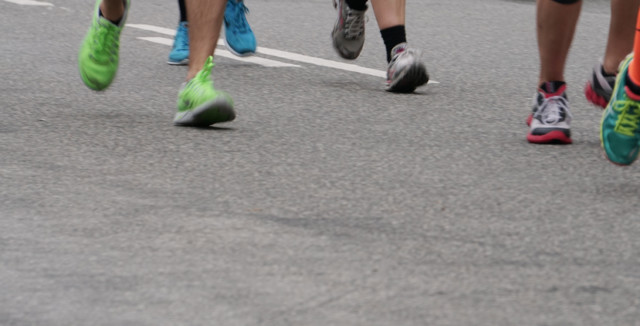Can Nonprofits Really Raise Money With 5Ks?

Marathon runners
According to the Blackbaud Peer-to-Peer Fundraising Study, 5K events are struggling to recruit participants and raise funds. Revenue declined by 13%, participation decreased by 12%, and online fundraising was down 19%. 5Ks have been historically difficult to raise funds through, but they seem to be having a particularly tough go of it lately. Are we as fundraisers failing this group of constituents? Are our runs subpar? And why can’t we ever seem to get these folks to fundraise?
When looking outside the nonprofit world, we also find that the running boom has slowed and after many years of increases, we now have two straight years of decreases in the amount of race finishers. Running USA publishes an annual report that studies road race trends and first reported a slight decline in 2014, followed by a 9% decline in the number of race finishers in 2015. Compounding the issue is that in the United States, we keep adding more road races. When looking at 5Ks specifically, the number of races increased by 8% while the overall number of finishers decreased by 9%. With the number of people participating in 5Ks decreasing and the number of available events increasing, individual events are seeing significant participant declines, which would explain the 12% decrease we saw in the P2P benchmark report.
From a revenue perspective, participants in 5Ks are stereotypically not very good fundraisers. Only 14% of them raise funds online, as compared to 31% of walkers and more than 60% of cyclist and endurance event participants. Let’s look at the top three reasons why this type of event doesn’t inspire as much fundraising as the others.
- Walking is not much of a hobby: Most folks who participate in a fundraising walk don’t sign up because the really enjoy walking. They sign up because they have a connection to the cause or because someone asked them to. They aren’t fantastic fundraisers, but more than twice as many of them raise money as compared to 5K runners.
- There is no implicit obligation to fundraise: The majority of cycling and endurance events require a certain level of fundraising to participate. From the minute you sign up, you know you need to raise funds.
- There is less personal challenge involved: While a 5K would be a difficult for many (the author of this post included), a 5K is not an intense challenge on the same level as a long-distance cycling event or half-marathon. Those events take more of a commitment both physically and from a fundraising perspective.
As fundraising staff, we’re up against a shrinking number of 5K participants and even when the participants do come to our events, the vast majority of them do not fundraise. So, what are we to do? Below are some bold ideas, not for the faint of heart, to bolster the performance of your 5K.
- Put “scarcity” to good use: Did you have 200 runners last year? Limit the field this year to 200 runners or less and make sure everyone knows it. The marketing principle of scarcity utilizes the appearance of a shortage to sell more. The fear of missing out will push more runners to your race.
- Generate more funds through registration and upgrades: According to the Benchmark Study, 38% of 5K revenue is derived from registration costs. Other types of events count registration fees as only 6% or less of their income. Rather than maligning this fact, it could be time to exploit it.
- Increase your registration fee: You can either do this across the board, or increase the fee at pre-determined points and advertise the fee schedule, making sure that those signing up on the day of the race pay the most.
- Charge a premium for upgrades: VIP parking, no wait porta-potties, pre- and post-race meals (donated), racing jerseys, and other wearables can all be offered to participants prior to and on the day of the event.
- By increasing fees and concentrating on upgrades, you do enforce a consumer culture for your event vs. a fundraising culture, but if you’ve been swimming against the fundraising tide for years with your 5K, it might just be time to accept it and generate income any way you can.
- Utilize a fundraising commitment: After all, you are putting on a safe, fun event for more than just the sake of a good run. You are trying to cure sickness, end hunger, or advocate for the homeless. Your work is important and it takes money to realize your goals. Allow your 5K runners to be a part of the solution and double down on fundraising.
- The Run to Home Base is a 5 and 9K race benefiting the nation’s first and largest private sector clinic devoted to healing invisible wounds for post-9/11 veterans, service members, and their families. To participate, there is a $25 registration fee and participants must raise either $500 or $750, depending on their registration date. Later registrants must fundraise more. Even children are required to pay the fee and raise $125. Organizers of the event don’t shy away from fundraising, and participants don’t only have the opportunity to run a great race, they get to do it knowing they are fundraising for a great cause!
If your 5K is faltering and has been for years, it could be time to take a bold and fearless approach to your event. Could one of these options work for your event?
But what happens when you have an event that is BOTH a walk and a 5K? Chances are, the event was designed to satisfy a larger amount of people. Perhaps it started off with both options in the beginning, or maybe one was added in an attempt to stem losses and/or generate more revenue. The problem with that, to oversimplify, is that runners run and walkers fundraise. As we have already explored, these two types of participants are very different and it is incredibly difficult to make fundraising/marketing decisions for an event that is trying to cater to both. If you are unable to separate the events physically, try to separate them from a marketing perspective. Offer two different website, registration, and communications experiences for each group. At the very least, ask during the registration process if they plan to walk or run and plan your communications to these two groups accordingly.
As we get ready to analyze 2016 P2P events, it will be fascinating to see how 5K data relates to the latest 2016 Running USA study when that is released as well. Stay tuned for the 2016 Blackbaud Peer-to-Peer Fundraising Study!
